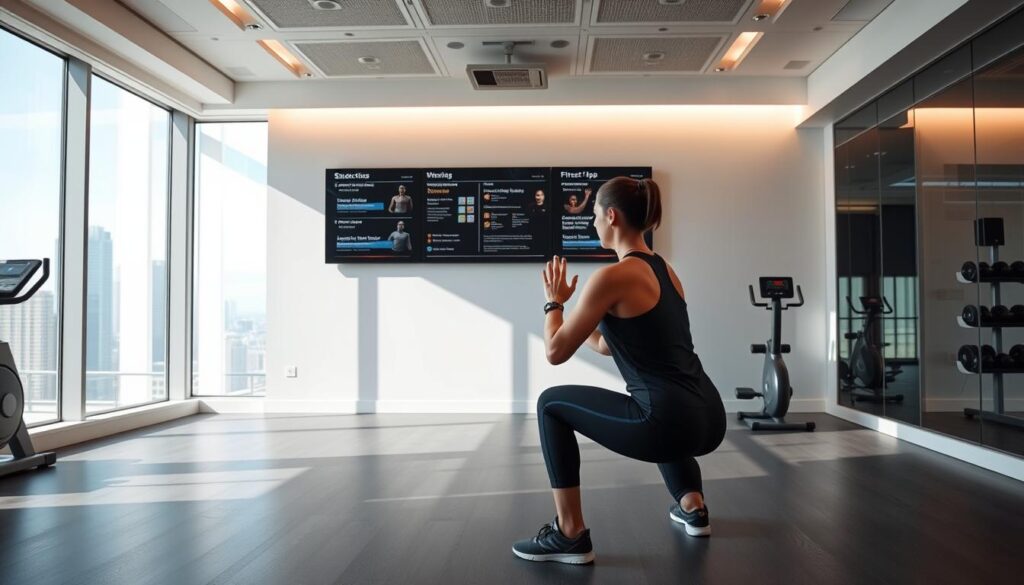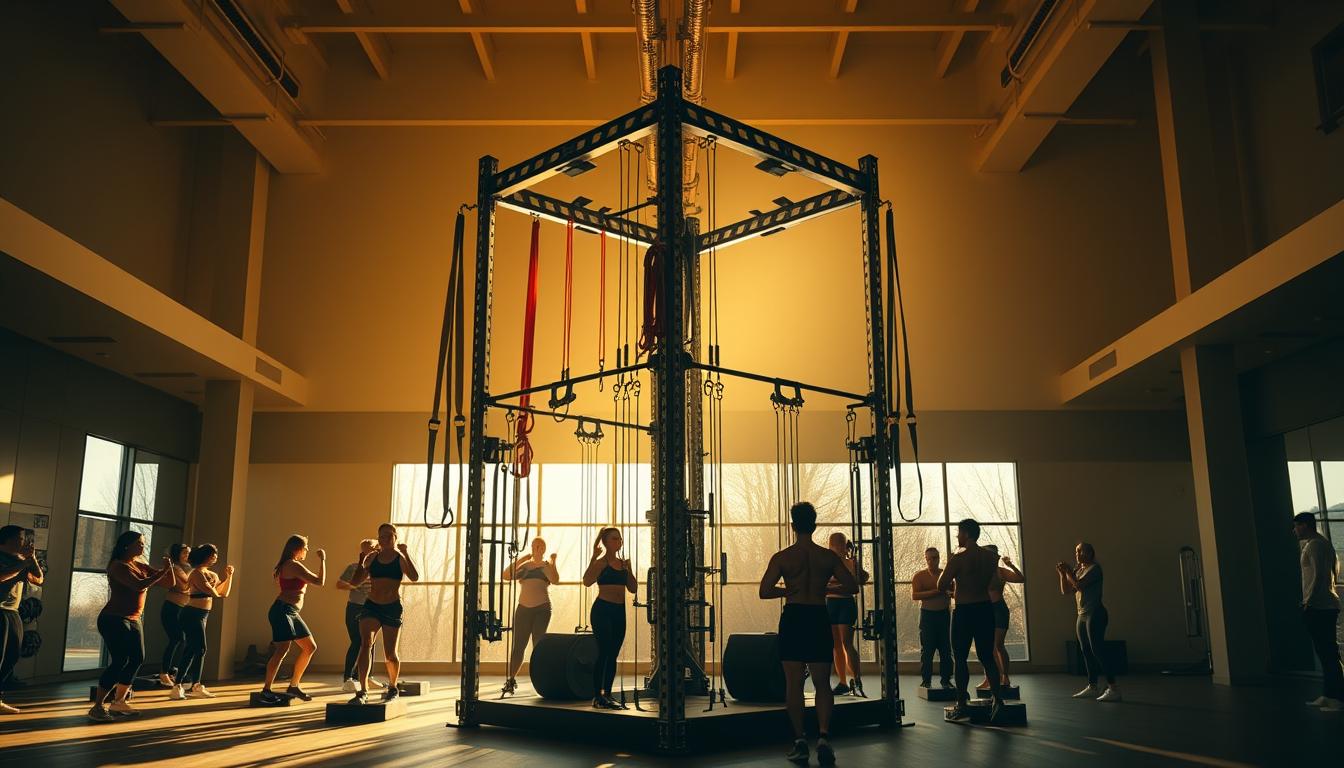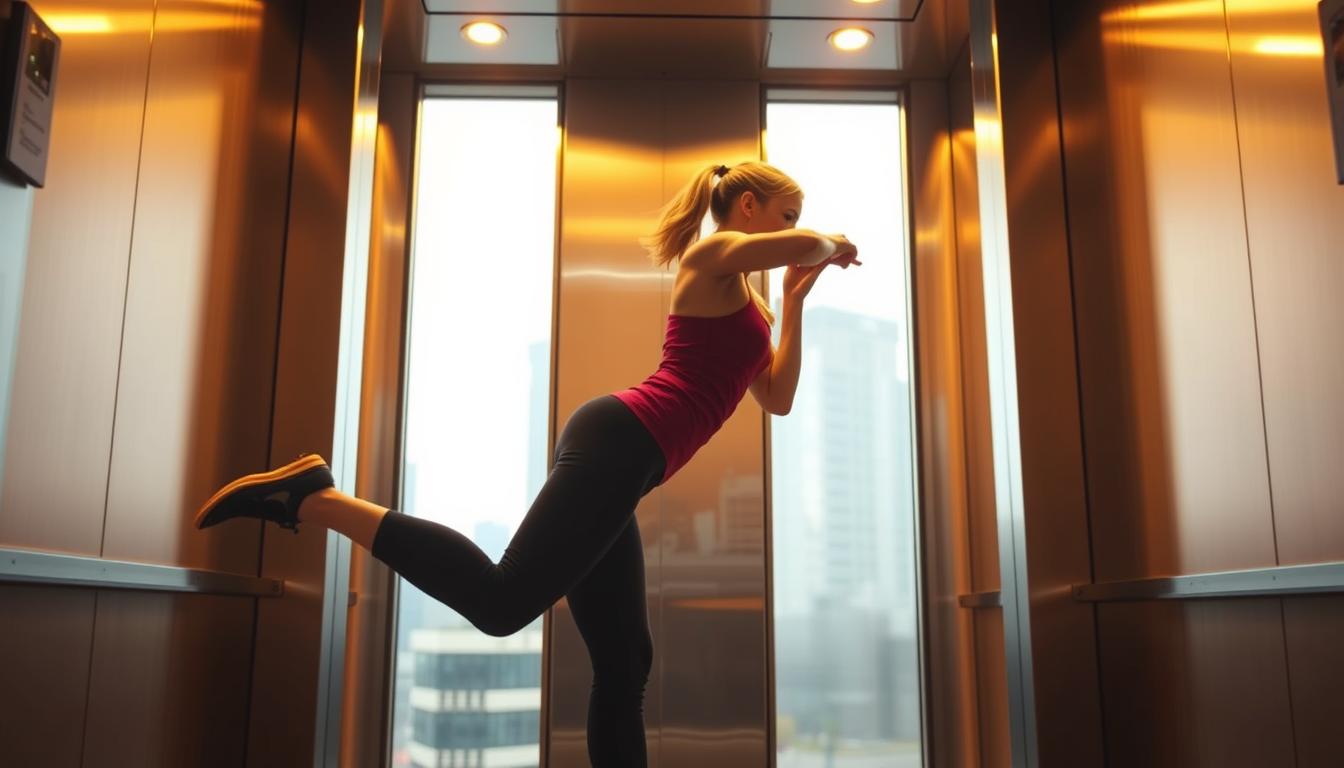Nowadays, it’s hard to find time for a good workout. That’s where elevator fitness comes in. It’s a smart way to fit in exercise while you’re moving around. You can do quick workouts while waiting for an elevator or during a short office break. We’ll look at easy ways to add fitness to your day, keeping you in shape no matter how busy you are.
Introduction to Elevator Fitness Exercises
Elevator fitness exercises are a smart way to fit exercise into your day, even in small spaces. This guide shows how you can turn wait times, like standing by an elevator, into a chance to work out anywhere. They mostly use your own body weight, so they’re perfect for beginners.
Proper form is key to making these exercises work and keeping you safe. Keep your back straight and shoulders relaxed to avoid injury. Controlling your movements helps your muscles work better and keeps you safe. Beginners should start slow, then build up as they get stronger.
Elevator fitness exercises let you improve your health without fancy gear. They’re good for all fitness levels and can be adjusted as needed. With regular practice, you’ll get stronger and more stable quickly. This method makes fitness achievable for everyone, including older adults.
Benefits of Incorporating Fitness Exercises into Your Daily Routine
Adding fitness exercises to your day can make you healthier overall. Even short activities can help manage weight by burning calories. This also stops unwanted weight gain. Doing regular exercises improves your mood and lowers stress by affecting your brain, making you feel better mentally.
Being active regularly gives you more energy. This energy boost can help you get more done every day. Making time for exercise also helps you sleep better, especially if you do it at the right times.
Adding exercises into your daily life is easy and convenient. It lets busy people keep up with their fitness without needing lots of time. Something as simple as taking the stairs over the elevator can add more activity to your day. This way, you enjoy the perks of staying active.
Simple Exercises You Can Do While Waiting
Fitting exercise into your day can be easy. Just use the times when you are not doing much, like waiting in line. Calf raises and buttock pinches are two easy exercises. They help make your muscles stronger and keep you fit while you wait.
Standing Calf Raises
Standing calf raises are good for your calves and help with balance. Stand up straight, lift your heels but keep your toes on the ground. Hold it to work your calf muscles. You don’t need any special gear for this exercise. It’s great for times when you have to stand around.
Buttock Pinches
Buttock pinches work your glutes and you can do them standing up. Just squeeze your glutes, hold for a bit, then let go. Do this repeatedly while waiting. Calf raises and buttock pinches use your waiting time wisely. They help you move towards your fitness goals, even in short moments.
Dynamic Exercises for a Quick Workout
Dynamic exercises are great for a quick workout. This helps increase your heart rate and works out many muscles. In just minutes, you can do movements like the running man, standing vertical jumps, and lateral raises with weights. These exercises don’t need much space and can be done anywhere, making them ideal for those with tight schedules.
Running Man
The running man is like running in place and gives your heart a good exercise. It targets your core and legs, raising your heartbeat and helping you burn calories. Adding this to your daily exercises can also make you quicker and more agile.
Standing Vertical Jumps
Standing vertical jumps really boost leg strength and power. You only need a small area to do this jump, which is great for short workouts. They work out your calves, quads, and glutes, making your lower body stronger.
Lateral Raises with Weights
You can use things like water bottles for lateral raises. These strengthen your arms and shoulders. It’s an easy way to build upper body strength, even on busy days. Make sure you’re doing it right to get the most out of it.
Stretching Moves You Can Perform Anywhere
It’s really important to stretch every day to keep your body flexible and ease muscle tightness. You can stretch in lots of places, breaking up the boredom of long sitting or standing spells. Here are some stretches to help your muscles stay relaxed and full of energy.
Hamstring Stretches
Hamstring stretches help loosen the back of your legs. To start, put one leg out straight and bend the other knee. Then lean forward slightly. You’ll feel a stretch along the back of your straight leg. This helps your legs move better and feel more comfy.
Quad Stretches
Quad stretches keep your thigh muscles flexible. You do this by standing on one leg and pulling the other foot towards your butt. Keep your knees together. Pull until you feel a nice stretch across your thighs. This helps ease muscle tightness and boosts your sports skills.
Shoulder Rolls
Shoulder rolls are great for easing neck and shoulder stress. You can do them standing or sitting. Just roll your shoulders in a big circle going backwards, then do the same forwards. This really simple stretch helps you keep a good posture and keeps pain at bay after sitting a long time.
Advanced Standing Exercises for Elevated Heart Rate
If you want to get your heart pumping, add advanced exercises to your daily routine. These exercises will build your strength and stamina. They don’t need much room and are fun to do.
Yoga Positions like Tree Pose
Yoga is great for you, and Tree Pose is especially good for balance and core strength. It makes your legs strong and helps you focus deeply. If you’re looking for a challenge, try adding Tree Pose to your workouts.
Squat Challenge with a Friend
Doing a Squat Challenge with a friend is a great way to have fun while exercising. It boosts both motivation and endurance as you work on your lower body. You’ll hit your fitness targets and enjoy being active with a buddy.
Creative Ways to Use Your Environment for Fitness
Looking for fitness spots in everyday places can make regular areas fun workout spaces. By using the environment creatively, people can exercise inside or outside using simple surroundings. For example, you can do prisoner squats, push-ups, and lunges anywhere without needing any equipment, even in small spots like elevators.
Things around the house can become handy weights, making your workout better. Water bottles or bags of cat litter work well for adding weight to squats or lunges. This shows that you can be fit anywhere in your daily life. Doing exercises like high knees, glute bridges, and core workouts in the elevator is a great way to use waiting time.
Important parts of this fitness method include using tension bands or adjustable kettlebells to make exercises harder. Elevators, for example, are great for bodyweight exercises. You can do squats, push-ups, and planks there. Adding arm circles and leg swings while you wait can turn wasted time into a useful exercise session.
Doing planks and Russian twists by holding the handrails is good for your core muscles. Adding calf raises and glute bridges helps with lower body strength. This proves small spaces can be great for workouts. Making elevator waits into mini, intense workouts keeps exercise exciting in a busy life.
You can also do assisted push-ups or tricep dips against the elevator’s walls or handrails for upper body workouts. Exercises like wall sits or seated leg lifts are perfect during those short waits. Stretching your hamstrings and back against elevator walls is good too. And doing balance exercises, like standing on one leg with handrail support, improves your stability and strength. A bit of creativity turns each workout into a special chance to mix fitness into your usual day.
Elevator Fitness Exercises to Tone Up in Limited Space
Finding ways to stay fit in small spaces can boost your health journey. Even in tight spots like elevators or small offices, you can still get a good workout. Here are some exercises that are perfect for these places.
- Wall Sit: This exercise targets the quadriceps, hamstrings, and glutes effectively while requiring no equipment.
- High Plank Hold: A great way to engage your abdominals, quadriceps, glutes, and arm muscles without any equipment.
- Side Plank: This move works your obliques and spinal stabilizers, providing strength and stability with no equipment needed.
- Low Squat: A simple yet effective exercise focusing on the quadriceps and glutes; no equipment is necessary.
- Overhead Hold: This targets your shoulder girdle, triceps, and core. Incorporate light weights or household items for added intensity.
- Glute Bridge: Focus on your hamstrings and glutes using minimal space.
- V-Sit: This exercise targets your abdominals and hip flexors, perfect for limited settings.
- Calf Raise and Hold: You can work your calves efficiently without needing much space.
- Squats and Lunges: Both movements can be done against a wall or chair for support, ideal for fitness in small areas.
- Push-Ups: Variations like wall push-ups, knee push-ups, or elevated push-ups using a sturdy stool suit tight environments.
- Rows with a Towel: Use a towel in a doorway to perform rows, offering an effective pull workout with minimal equipment.
- Towel Deadlifts: Focus on proper form while simulating deadlifts with a towel for bodyweight resistance.
- Towel Chin-Ups: Mimic chin-ups using a towel and a sturdy door for innovative training of pull muscles.
Adding these exercises to your routine can really help tone your body. You’ll make the most of the space you have.
Tips for Staying Consistent with Elevator Fitness Exercises
Staying fit can often be tough, especially when life gets busy. To help you keep up with your elevator fitness plan, here are some handy tips:
- Overcome mental barriers: Start by setting small goals you can hit. Then, celebrate each success to boost your confidence and drive.
- Set specific times for exercise: Planning your elevator workouts for the same times can help you stick to a schedule.
- Use triggers: Link your exercises to daily cues, like after eating or when you get to work, to form a habit.
- Reward yourself: Treat yourself a little after each workout to keep the good vibes flowing.
- Log your workouts: Write down your exercise routine to track your progress and stay on course.
- Incorporate into daily life: Use work breaks or errand runs to sneak in quick workouts for easier habit building.
- Stay motivated: Mix your workouts with fun activities or music to keep things interesting and consistent.
- Incorporate variety: Changing up your routine helps beat boredom and reduces injury risks.
- Gradually increase intensity: Boost the challenge gradually to build more endurance and strength over time.
- Warm up and cool down: Always start and finish your workouts with warm-up and cool-down sessions to avoid hurting yourself.
- Combine different exercises: Bringing together aerobic, strength, and balance exercises can improve your overall health.

Combining Elevator Fitness Exercises with Your Regular Routine
Adding elevator fitness exercises to your daily schedule boosts your health. Try simple moves like calf raises while getting coffee or stretching during breaks. These help make exercising a regular part of your life without much effort.
When you mix exercises that get your heart pumping with strength activities, you make the most of your workout. For example, do squats while waiting for the elevator. This approach helps improve both your muscle and heart health gradually. It’s about blending cardio with strength exercises during your day.
Using complex moves, like those with dumbbells or kettlebells, is also smart. They let you do a range of exercises back-to-back, boosting your coordination and heart health. These are great to start or finish a workout session, making your fitness routine complete.
Cardio activities, like fast walking or taking stairs, boost heart health and stamina. Resistance exercises, like using a band, help avoid injuries and improve how your body works. Doing balance exercises makes you more stable and can reduce the risk of falls. This makes daily life safer and better.
It’s crucial to stay safe while exercising. Always warm up first. Remember to breathe properly during exercises and use support if needed. By making these practices a part of your day, you can easily blend exercise with your routine tasks. This will lead to better health and fitness.
Conclusion
Fitness exercises in elevators are both useful and easy for people wanting to get in shape. They turn waiting time into a chance to work out, making fitness fit easily into everyone’s day. No matter where you are or how little time you have, you can stay on track with your fitness goals.
These workouts do more than just make you stronger and help your heart. They also make you feel happier by releasing endorphins. Plus, picking the stairs helps you pay more attention to the world around you. This is all important for feeling mentally good. Adding these exercises into your routine helps keep you independent and living a good life as you get older.
Adding these small workout moments into your day can bring big benefits for your health over time. By choosing to exercise in the elevator, you’re not just focusing on fitness. You’re choosing a healthier way of life and building strength to face life’s challenges. So, next time, skip the lift and take the stairs. Enjoy the steps you take towards a happier, active life.



